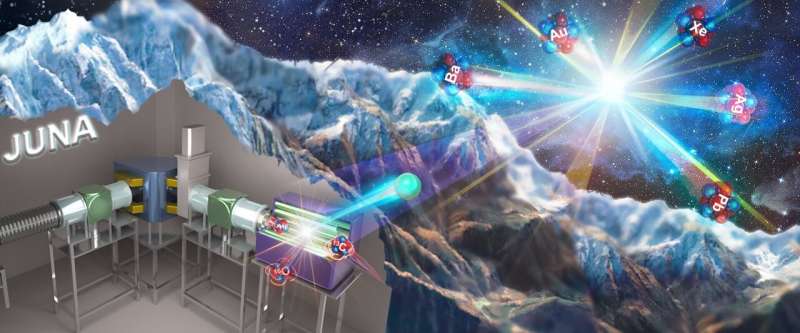New measurement of stellar neutron source reaction resolves long-standing discrepancies

The Jinping Underground Nuclear Astrophysics (JUNA) collaboration has reported a recent direct measurement of the cross section of a crucial stellar neutron source reaction, 13C(α,n)16O. The study was published in Physical Review Letters on September 23.
By achieving the most accurate cross sectional measurement of this reaction at astrophysical energies so far, the study has resolved long-standing discrepancies among previous data on this reaction, which is essential for understanding the origin and abundance of elements heavier than iron in the universe.
The origin of such elements is one of 11 Physics Questions for the 21st Century and neutrons are the key to transforming iron into heavier elements. The rate of the neutron source reaction determines how many of these heavier elements can be produced in stars.
The 13C(α,n)16O reaction, first proposed in theory as the primary neutron source in stars by Cameron and Greenstein in 1954, provides neutrons needed in the synthesis of roughly half of all heavier-than-iron elements in the universe. It has long been a goal of experimental nuclear astrophysics to accurately measure this reaction at astrophysical energies (0.15–0.54 MeV). However, the corresponding reaction cross section is extremely small, which makes it very difficult to measure.
During the past seven years, the JUNA collaboration has developed a variety of scientific equipment installed at the China Jinping underground Laboratory (CJPL), which is currently the deepest underground laboratory in the world. The equipment includes an accelerator delivering the most intense α beam in the underground laboratories worldwide; high-power, thick targets that can survive bombardment by an intensive beam of hundreds of coulombs; and a high-sensitivity, low-background neutron detection array.
Taking advantage of these developments and the ultra-low background environment at CJPL, the research team successfully performed a direct measurement of the cross section of the 13C(α,n)16O reaction in the astrophysical energy range of 0.24–0.59 MeV. The measured energy range was further extended to 1.9 MeV by using the 3 MV tandem accelerator at Sichuan University.
Providing the first consistent measurement covering the energy range from the stellar energy region up to high energies, the study obtained the most accurate stellar reaction rate for the 13C(α,n)16O reaction to date.
"The present precise data of this reaction cross section provide with the firm basis to develop astronomical models of the i- and s-process nucleosyntheses to construct a new picture of Galactic chemical evolution of heavy nuclei," said Prof. Kajino, a nuclear astrophysicist from Beihang University.
More information: B. Gao et al, Deep Underground Laboratory Measurement of C13(α,n)O16 in the Gamow Windows of the s and i Processes, Physical Review Letters (2022). DOI: 10.1103/PhysRevLett.129.132701
Journal information: Physical Review Letters
Provided by Chinese Academy of Sciences




















